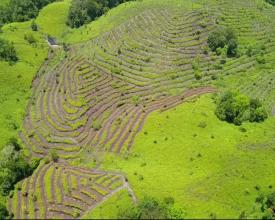Life - La restauration écologique par le biais de partenariats

Biodiversity Sri Lanka, en partenariat avec le Département des forêts du Sri Lanka, l'UICN Sri Lanka et certains partenaires du secteur privé, a entrepris un projet pilote visant à établir une base de référence pour la biodiversité dans une zone de 10 hectares de forêt pluviale dégradée, qui a été défrichée pour la culture et ensuite abandonnée, ce qui a entraîné la colonisation de cette zone par l'espèce de fougère pionnière Dicranopteris linearis, située dans la forêt de conservation de Kanneliya. L'intention était de restaurer cette zone en utilisant les principes de l'écologie de la restauration, afin d'améliorer ses fonctions écologiques, la qualité de l'habitat, la diversité des espèces et sa capacité à fournir une biodiversité et des services écosystémiques proches de la forêt de plaine humide environnante dont elle faisait partie auparavant, avant qu'elle ne soit convertie dans son état actuel.Le projet visait à développer un système d'accumulation de crédits de biodiversité pour le Sri Lanka en utilisant les connaissances acquises, dans le but d'attribuer une valeur unitaire à l'amélioration de la biodiversité et des services écosystémiques.
Impacts
Les partenaires impliqués dans le projet pilote seront reconnus comme les pionniers de ce nouveau système et seront les premières entreprises du secteur privé à obtenir des crédits de biodiversité à partir d'activités de restauration, qui seront enregistrés dans un "Bio-registre" et pourront être utilisés ultérieurement pour une compensation gérée de leur empreinte sur la biodiversité. Le projet surveille également les progrès en ce qui concerne les changements dans la diversité et la composition des espèces dans la zone restaurée et les changements mesurables dans les services écosystémiques tels que l'amélioration de la qualité et de la quantité du sol et de l'eau dans le site de restauration.Les partenaires contribueront à la formulation d'un livre blanc à l'intention des agences de l'État en vue de l'élaboration d'une politique nationale bien pensée en matière de compensation de la biodiversité, ce qui permettra aux propriétaires de projets d'être incités à gérer des terres à des fins de conservation pour la première fois dans le pays. Il s'agit également d'un moyen d'améliorer les moyens de subsistance des communautés environnantes grâce à des avantages indirects tels que l'amélioration des services écosystémiques fournis par le projet et l'implication directe en termes d'emploi dans les différents rôles requis par le projet.
